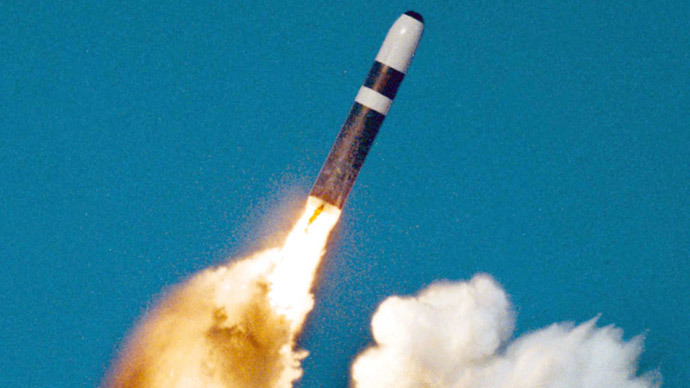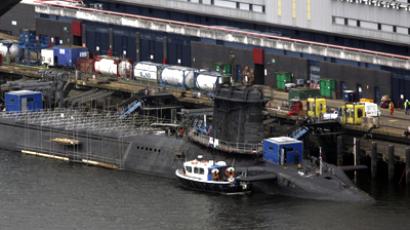Young Brits say nuke arsenal upgrade not a priority

While the Royal Navy is feverishly trying to raise money for the proposed 100-billion-pound modernization of vintage US-made seaborne Trident missiles, a recent survey suggests young Britons do not regard nuclear combat readiness as a priority for the UK.
A survey conducted at the commission of WMD Awareness campaigning group has revealed that young UK citizens born after the end of the Cold War do not believe that nuclear deterrence is important at all.
Less than half of the questioned British citizens (38 percent) support the idea that possession of nukes protects the country from modern threats such as terrorism.
Even among the older generation of over-35s, only a third (33 percent) agrees that maintaining nuclear forces in current size and capacity is vital for the state. Among the younger group of 18-35, such support is nearly twice as rare (19 percent).
Only one out of 15, or 6 percent of the poll, believes defense spending is a priority for London for the next decade.
The poll involved 4,207 British citizens aged over 18. Of those 1,108 were aged 18-35. It was carried out by ComRes to find out the general attitude of the British citizens towards the future of British WMD and upgrade of the Trident nuclear missile system and submarine fleet that carries them.
A discussion is underway in Great Britain regarding the necessity to modernize the Trident system that is estimated to cost the country up to 100 billion pounds (US$167 billion) within a 25-year period. London has been dependent on American missiles over the past few decades. All four British nuclear submarine missile carriers are armed with American Trident-II missiles.
The family of America’s Trident missiles was developed in the 1970s and since then has been modernized several times.
According to the 2010 Strategic Defense and Security Review, London currently possesses a stockpile of 225 thermonuclear warheads for Trident missiles of the Vanguard submarine fleet. This number is gradually being reduced to approximately 180, of which only 120 warheads are going to be ‘operationally available’ until the late 2030s.
In 2002, the US Navy announced the beginning of the D5 Life Extension Program (D5LEP) in order to extend the life of the nation’s nuclear missile submarines to the year 2040. By 2011, the program had cost Washington nearly $40 billion, with an estimated $70 million upgrade cost for a single missile.
London and Washington are conducting secret talks on the issue of Trident missiles upgrade within the framework of “a very special bilateral relationship,” reported the Guardian. The very future of the British nuclear arsenal is at stake, because Washington has so far not take a final decision on the shape of its future nuclear forces, so Britain simply has to wait until the US military has agreed on the future of its own arsenal.
The British government has already spent 300 million pounds on design work of possible new fleet of nuclear subs armed with Trident intercontinental ballistic missiles, yet the final decision is likely to be taken in 2016, after the next year’s general elections in UK.
The UK's current nuclear arsenal of Trident missiles is carried by four Vanguard class submarines operating from Faslane Naval Base, Scotland. One is deployed at open sea at all times to maintain country’s nuclear retaliation strike capability in case of an assault.

Ahead of this year’s independence referendum in Scotland, London finds itself in an odd situation that it could potentially be stripped of the Faslane Naval Base, its primary nuclear deterrence forces facility.
One year ago NATO Secretary General Anders Fogh Rasmussen admitted that “if European defense spending cuts continue, Europe’s ability to be a stabilizing force even in its neighborhood will rapidly disappear.”
A year later, when amidst the turmoil in Ukraine, the autonomous region of Crimea voting in favor of reuniting with Russia, NATO's secretary general stressed again in an article in Britain’s the Telegraph, that the alliance member states should modernize their armed forces and spend more on defense in general, threatening that Russia is trying “to turn back the clock and carve up Europe into new spheres of influence.”
Over the last two decades Russia has developed several new and modernized outdated nuclear missile complexes and is successfully re-arming its nuclear triad. For example, modernization of the country’s stalwart seaborne Sineva nuclear missile (four thermonuclear warheads) into a new Liner version (10 warheads) cost Russian budget less than $2 million for each missile.
All Russian third generation SSBNs will be re-armed with Liner missiles by 2020.
Russia’s fourth-generation Borey-class SSBNs are armed with brand new solid-fueled Bulava missiles with next-generation missile shield-piercing capabilities.













